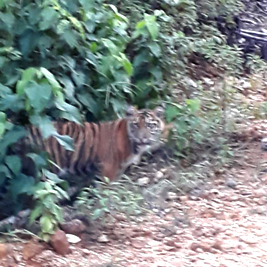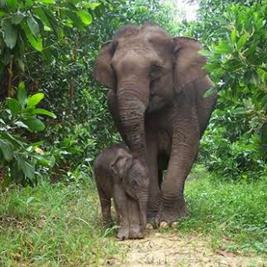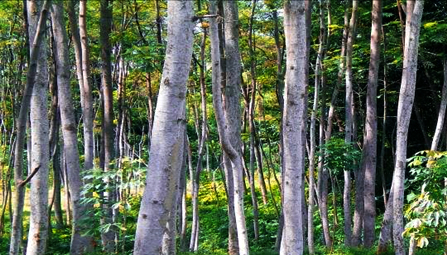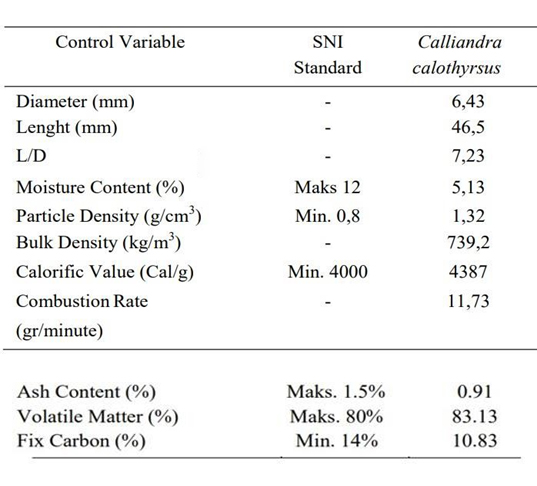A visionary approach to environmental stewardship
Nature-based Real Assets and Natural Capital Strategies
The Forest Edge Management
We oversee diversified management that includes sustainable timber plantations, conservation areas, carbon and conservation finance projects, agriculture, timber processing..
Our mission is to create shared prosperity for our EcoToken holders and the communities we serve, while accelerating the transition to a sustainable future.
The Forest Edge Project is ICE’s plan for the sustainable environmental management of a 10,384 ha Forestry Concession in Aceh Province, and consists of the production of wood pellets as sustainable fuel for electricity generation, the conservation of 3,800 ha of primary rainforest, and other supporting and community-based activities.
UN Sustainable Development Goals
We support the UN Sustainable Development Goals, and our ForestEdge Project addresses these nine SDGs directly.
ForestEdge is designed to be resilient, forward thinking and grounded in partnership with local communities but with global impact on forest conservation, biodiversity and the development of a just and sustainable economy in Aceh.
Conservation & Environmental Management
The opportunity to provide additional habitat for critically endangered tigers, elephants, orangutans, and rhinos in the area is important.
The Concession contains approximately 3,800 ha of primary forest, which is contiguous to the Leuser Ecosystem and therefore contributes to its capacity and biodiversity. All or most of this area will be designated and publicly disclosed as the Forest Edge Conservation Area. Management will take a number of steps to preserve, understand and enhance the Conservation Area:
-
- Protect the forest ecosystem, to the extent feasible, from damage due to forest fires, illegal logging, poaching and economic activity
- Maintain and repair the forest to correct for the effects of natural and manmade threats or damage to the health of the forest ecosystem
- Map the area so that its elevation, land use, plant life, soil conditions, access roads and trails and watersheds are known to a resolution of at most 1 meter
- Survey and map the sequestration of carbon throughout the conservation area, audit these figures for carbon credit certification purposes, and monitor changes over time
- Take a census of animal life with a focus on large mammals and identify and seek to remedy any threats to their populations or the resources on which they rely
- Reintroduce or augment populations of endangered plant and animal species and assist the biosystem to resist the incursion of invasive species
- Establish infrastructure for real time monitoring of animal life, plant growth and unwanted incursions
The entire area is habitat for Sumatran tiger and elephants with recent sightings of both. Evidence of sightings photographed by staff at Forest Edge.


Many rainforest conservation projects globally do not have any plan to intervene in the natural forest in any way. While passive conservation efforts are undoubtedly making positive contributions, management believes that active forest management is better for the environment and more likely to deal effectively with threats to the ecosystem.
From time to time management intends to designate additional Conservation Area within the Concession. This may result either from a determination that the forest is in good condition and will not be used for other purposes, or from plans to conduct reforestation activities for the purpose of adding to the Conservation Area.
Management may sponsor, establish or permit economic activities within the Conservation Area, if in its judgment such activities are not contrary to the objectives of the conservation activities. These activities may include:
-
- Shade crops and nonintrusive agriculture ancillary to human settlements and livelihood activities conducted outside of the Conservation Area
- The gathering of honey, bird nests or rattan, or other nondamaging human foraging activities, ancillary to nearby human settlements and livelihood activities
- The survey, study and potential sale of flora and botanical chemicals for use in the pharmaceutical and fragrance industries
- Hiking trails and canopy walks constructed and maintained in support of eco-tourism business activities based outside of the Conservation Area
Interest in conserving forest land in order to generate carbon credits has waned in recent years due to widespread criticism of the certification methods for Voluntary Emission Reductions. What is typically under review is whether the carbon sequestered in a natural forest has been threatened with release into the atmosphere, and whether that threat has been successfully averted. These are hypothetical questions and some of the answers accepted did not withstand scruitiny.
We understand why it is important to ask whether the release of carbon dioxide is threatened, and why it is important to stop threatened releases. But we do not believe that forest conservation efforts should be limited to cases where there is an imminent threat to be averted. The dwindling global supply of natural rainforest should be conserved everywhere, including in places where there is no imminent threat, and those conservation measures should include active efforts.
This is not to say that there is no threat of release of the carbon sequestered in the rainforest of Forest Edge. The Concession states that the forest is to be logged and converted into a plantation, and we have acquired the Concession so that the remaining primary forest within the Concession will not be logged.
Nonetheless, management does not presently have any plans to engage in hypothetical threat assessments in order to certify carbon emission reductions. We are hopeful that a system will be adopted in which all rainforest conservation efforts are rewarded whether or not they are deployed in the face of an imminent threat.
Management will seek appropriate opportunities for the Project to earn compensation for sequestration of carbon or avoided release of carbon into the atmosphere, for protection of endangered animal species, or for other desired conservation outcomes. To the extent feasible, such compensation will be attributed to specific areas within the Concession.
Wood Pellet Production
Six hectares of the Avoided Deforestation Block were previously logged, but the activity was stopped pre-pandemic. Baseline landuse scenario is that open grassland and scrub will be developed as sustainable, fast-growing plantations.


The production of wood pellets is intended to assure that the entire Forest Edge Project will be economically sustainable, even without any revenue from conservation activities. Between 3,000 and 6,000 ha of the Concession will be set aside for a Plantation to produce feedstock for this purpose.
The primary tree to be grown in the Plantation is expected to be a species of the genus Calliandra. The land to be planted has not yet been determined, but will not include any primary forest. A portion of the Plantation Area may be deeded to Plantation workers, who will plant and harvest the same crop and sell their production to the Project.
Pending the first harvest of the Plantation, management estimates that many years of feedstock for wood pellet production can be harvested from the future area of the Plantation, which consists of degraded forest much of which has previously been logged. This area can also supply wood for sale to third parties prior to the construction of the wood pellet factory.

ICE estimates that a wood pellet factory able to produce 4 tons of wood pellets per hour could be built for less than US$1 million, excluding the cost of the factory land and building. If feasible, ICE will lease existing land and building for the factory in or near the Port of Lhoksemawe, Aceh. A 4 ton/hour wood pellet factory could in principle produce 24,000 tons of wood pellets per year, which if sold for US$150/ton FOB, would generate US$3.6 million/year of gross revenue to the Project.
Many countries have adopted a policy of using biomass as fuel in their power plants originally designed to burn coal. These countries include Japan, Korea and EU member countries. Indonesia has adopted a similar policy, but it does not yet have procurement policies that make it economically attractive to sell wood pellets as fuel for Indonesian power plants. Therefore it is assumed that the wood pellet production will be exported.
Although it is unfortunate that carbon sequestered in the wood pellets will be released into the atmosphere when it is used as fuel for electricity, a similar amount of carbon will be reabsorbed by the Plantation as it grows, and this has been deemed by policymakers as an acceptable energy transition policy, pending the eventual retirement of coal-fired power plants.
The EU imposes strict certification requirements on imported wood pellets. ICE intends to meet these requirements in order to avail itself of the premium prices currently offered by EU wood pellet buyers, in the range of US$200-300/ton. Korean buyers have the most lenient requirements for wood pellets, and pay the lowest prices, currently at about US$110/ton. Japan is between the EU and Korea in both certification requirements and price, and is currently buying wood pellets at around US$150/ton.
Calliandra Calothyrsus
Calliandra Calothyrsus, commonly known as Calliandra, is a fast-growing leguminous tree that has several attributes that make it commercially viable for wood pellet production. Calliandra calothyrsus was introduced to Indonesia in the early 20th century, around the 1930s. Initially brought in for use as a shade tree in coffee plantations, it later gained popularity for its multiple uses, including as fodder, firewood, and for soil improvement due to its nitrogen-fixing capabilities. The species has since been widely adopted in agroforestry systems across the country.


Fast Growth and High Biomass Yield
- Rapid Growth Rate: Calliandra can reach maturity in 2-3 years, providing a quick biomass yield.
- High Biomass Production: The plant can produce significant amounts of biomass per hectare, making it a reliable source for wood pellet production.
Energy Content
- High Calorific Value: Calliandra wood has a relatively high energy content, which makes it suitable for efficient energy production when converted into pellets.
- Low Moisture Content: The wood of calliandra tends to have low moisture content, reducing the energy required for drying and increasing the efficiency of pellet production.
Environmental Benefits
- Nitrogen Fixation: As a leguminous plant, calliandra enhances soil fertility through nitrogen fixation, which can improve the productivity of degraded lands and reduce the need for chemical fertilizers.
- Sustainability: Calliandra’s ability to grow on marginal lands without heavy inputs makes it an environmentally sustainable option for biomass production.
Economic Viability
- Low Production Costs: The ease of cultivation and low input requirements contribute to lower production costs compared to other biomass sources.
- Versatile Usage: Besides wood pellets, calliandra can be used for fodder, soil improvement, and erosion control, providing multiple revenue streams for farmers.
Market Demand
- Rising Demand for Biomass: The increasing global demand for renewable energy sources, including biomass and wood pellets, supports the commercial viability of calliandra as a feedstock.
- Policy Support: Government policies promoting renewable energy and sustainable land management practices can enhance the market potential for calliandra-based wood pellets.
Other Economic Activities
Parts of the Concession which are not designated as either Conservation Area or Plantation Area may be allocated to a variety of uses to the extent permitted by law and by the terms of the HTI License. To the extent these activities generate profits to the Project independent of Plantation and Conservation activities, they may be shared among Stakeholders, reinvested in Plantation and Conservation activities, or used to support community engagement with local populations.
There are a number of facilities which will be required in support of the activities already described, whose land use will not constitute either Conservation Area or Plantation Area. These include:
-
- Project site offices for Conservation, Plantation or both
- Plantation product processing and staging areas
- Plantation species and Conservation Area management nursery
- Rainforest study facilities
- Residences for Conservation and Plantation staff, including mess hall and temporary accommodations
- One or more eco-tourism, rainforest or safari resorts
- Existing and expanded business establishments along the existing road through the Concession
- Farming communities which will engage in non-intrusive agricultural activities within the Concession and their cropland
To the extent land remains available after allocation of Conservation and Plantation Areas, and to the extent permitted by law, the Project may also set aside areas for unrelated activities such as food farming or educational institutions.









